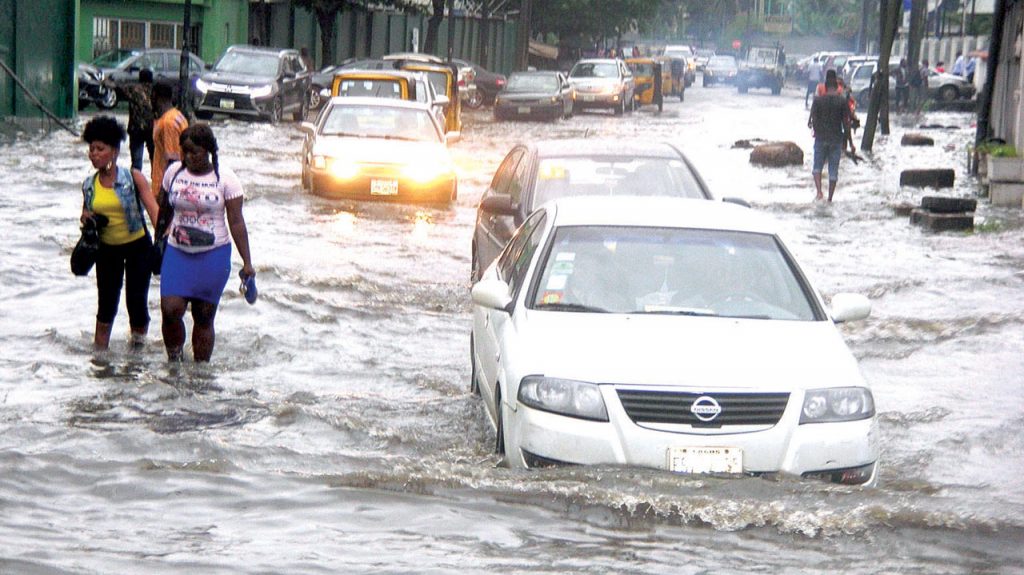The Lagos floods which has been moving destructively has reportedly claimed the lives of 3 children. Persistent rain on the 7th and 8th of July 2022 has reopened an old but recurring wound in the lives of Lagosians.

Although 8 lives were saved during that time, the lives of Micheal, 18; Elizabeth, 17; and Timi, 14 were sadly lost while they were trying to relocate from their home to a church structure nearby. As sad as this may sound, it is one in a series of events that has become something of a yearly ritual for those residing in Lagos
What Causes The Lagos Floods?
Lagos, one of the most populous cities in Nigeria with a population of about 1 million people is a major economic hub in the west of Nigeria. It is boarded on one side by the Atlantic ocean. It comprises of an island and a mainland intertwined by strings of other islands and water.
Its unique location makes the city vulnerable to great flooding, especially between March and November. Whether it is because of a lack of effort on the government’s part, or the adverse effect of climate change, the floodings in Lagos remain an annual menace and its impact is felt by both the rich and the poor alike.
Because of the annual nature of the flooding and the proximity of the land to the water, the Lagos coastline is gradually eroding. This alongside the sand mining being done for the numerous properties being built in the city has made subsequent floodings worse than the proceeding ones.
How Bad Are The Lagos Floods?
Every Lagos resident is aware of the deplorable state of certain areas in Lagos when this season comes and the waters swell. The level of water increases based on the cause of the flooding, either the water around the islands overflows its banks or flash floods occur when rain falls hard and long.
Whatever the case, life, both economic and social life alike suffers terribly during these times. Community life as a whole is disrupted as means of livelihood, properties and lives are lost and damaged.
Places commonly affected by floods are low terrain areas, closer to the water bodies, they include Alimosho LGA, Eti-Osa LGA, Ajeromi, Apapa, Amuwo-Odufin, and Kosofe.
Why Is Lekki Always Flooded?
Lekki is one of the closest regions to the Atlantic ocean with sloping topography. Asides this, it also has a shallow and unclean drainage system. These factors contribute to the reason why Lekki is at high risk of flooding during seasons of persistent rainfall.
The regions most affected by Lagos floods are:
Agungi Region:
The Agungi region of Lekki, the residing area of most of the affluent, is most prone to flooding. The residential area and gated neighbourhood face a lot of water-logged areas and movement can be made difficult at times.

Ikate:
Ikate is another area where there are comfortable and affluent neighbourhoods spread all around. Also known as Elegushi, it is close to the Atlantic ocean and is sometimes known for having a steady flow of water all year long
Victoria Garden City:
Home to creme de la creme of Nigeria, this beautiful area is not exempted from this menace. Over the years, celebrities have shared their disappointment with the water levels and how bad it can get whenever flash floods happen. One would think that disasters like this would not happen in rich neighbourhoods, but the floods in Lagos is clearly no respecter of persons.
Other places ravaged by these floods in Lekki are Chevvy View Estate, Ikota Villa, Ocean Bay, Ajah, Buena Vista Estate, Monastery Road, Sangotedo and Westend Estate.
In order to curb this menace, it has been suggested by the residents that the bad drainage systems should be fixed and measures provided by the government to reduce the erosion of the coastline. The communities, on the other hand, have been advised to provide awareness for the people to teach them survival tactics during seasons of persistent rainfall to reduce the loss of lives.















